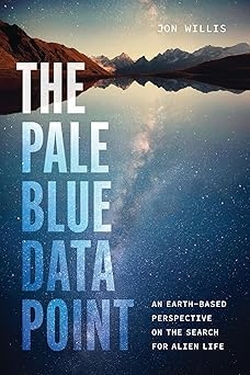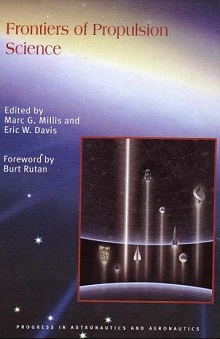Centauri Dreams
Imagining and Planning Interstellar Exploration
Aspects of Interstellar Transhumanism
In Shakespeare’s famous lines from The Tempest, the spirit Ariel addresses Ferdinand, prince of Naples, now grieving over the death of his father in the shipwreck that has brought them to a remote island in an earlier era of exploration. The lines have an eerie punch given our discussion of the changes humanity may bring upon itself as we adapt to deep space:
Full fathom five thy father lies;
Of his bones are coral made;
Those are pearls that were his eyes;
Nothing of him that doth fade,
But doth suffer a sea-change
Into something rich and strange…
From this has emerged the modern shadings on ‘sea-change,’ yet another Shakespearean coinage that has enriched the language. I thought about The Tempest while reading through the Working Track Report from TVIW 2016, a symposium in which these adaptations took center stage. The new edition of Stellaris: People of the Stars (Baen, 2020), discussed last Friday, contains the short report, prompting this examination of its conclusions along with a look at some of the fiction and non-fiction that takes up the bulk of the volume, all on the topic of human transformation.
Species Bifurcation at the Oort
In what sense will interstellar travelers be humans like us, and in what sense will they become a new species? One point that emerged in the discussions in Chattanooga was that adaptations to our species will be mission-specific. Exploratory expeditions have the need to adapt to issues like isolation and long confinement as well as, depending on spacecraft configuration, low gravity or other controllable environmental factors. Actual colonies have far different needs: Long-term adaptation to an environment possibly much unlike Earth and the need to support and sustain a growing population. The kinds of human engineering we’ve been discussing come into play, though through a natural process of development, destination by destination.
Imposing genetic and/or physical changes will be slow and adaptive, and doubtless the process will only be possible if begun and examined thoroughly in a space-based infrastructure right here in the Solar System. A multi-generational human presence in space also allows the social structures to develop that can support life off-planet, though these will doubtless evolve within specific mission parameters.
The generation that leaves the Solar System for the first time may face sharp distinctions in its mode of travel. Shorter exploratory missions to nearby stars make their own demands, different from those experienced by worldships that move at much slower pace, producing generations that are born and live out their lives on the vessel. In a sense, worldships can be seen as antithetical to interstellar colonization, if as the working track participants did, we make the assumption that spacecraft on this scale develop their own kind of inhabitants:
Worldships are an end in and of themselves. Moving such a large biosphere to another star system would likely take centuries. If a worldship would be viable for the projected duration of the mission, then it would most likely be viable well in excess of that timeline. Thus, a worldship is a colony; once established, attaching engines or even an interstellar drive to a worldship may provide mobility, but to what end? Furthermore, if it is used merely as a vessel to transport colony and crew, then what is the guarantee that they will want to leave the habitat once the destination is reached?
I’ve written before about the prospect of an important bifurcation in our species on this issue. Those who inhabit massive space structures — perhaps hollowed-out asteroids, or arcologies ‘grown’ in space by future forms of nanotech — and those who live on planetary surfaces and choose to travel through faster technologies to planets around other stars. I can imagine ‘slow boat’ travel between the stars as humans move gradually out into the Oort Cloud exploiting cometary resources and eventually moving into a presumably similar cloud around the Centauri stars, for example. Here we’re talking about missions in the thousands of years, and ‘crews’ — inhabitants — who may well choose to move on to another system after studying the first.
By contrast, those shorter exploratory missions, given the problems of propulsion, may themselves be, at minimum, decades long and likely centuries. Here the Working Track saw the need for deep sleep:
…interstellar exploration will most likely require some form of metabolic suspension. While such medical technology is still science fiction, it has its roots in present-day advances in surgical techniques, in the as-yet-unexplored functions resident in what has been called junk DNA, and in lessons learned from vertebrate animals which can successfully survive freezing temperatures without damage to cells caused by the formation of ice crystals.
Alternating crew shifts into and out of hibernation could sharply reduce the subjective passage of time, with ramifications for both social engineering and life support systems.

Image: The vast interior of an O’Neill cylinder presents a more spacious view of what a worldship might become. Credit: Rick Guidice/NASA.
The Biomedical Transition: Shifting the Curves
You would think that technologies like CRISPR already take us a long way toward the modification of the human genome, but the way ahead is challenging indeed as we go from treating single diseases like cystic fibrosis to modifying complex traits of intelligence or longevity. It’s the difference between single-gene engineering and dealing with hundreds of genes and their interactions over time and changing environments. Thus Nikhil Rao (University of Florida), whose contribution to Stellaris explores the outcomes we want to achieve as we go transhuman.
No easy matter, this, for as Rao puts it:
Ultimately, most positive traits in humans are emergent functions of genes, environment, our interactions, and time. While gene manipulation and nanotechnology may modify these processes, potentially eliminating negative traits, they will likely not change the fact that human traits are ultimately distributed along a series of bell curves, even as science shifts the shape of those curves.
Shifting those curves will involve adjustments to the human immune function, mild immunodeficiency being surprisingly common. We might see accelerated evolution in Earth-based pathogens that have been unwittingly carried with us onto a worldship, for example. A seasonal allergy is an example of something that triggers inflammation and destruction of the body’s own tissues as a response to pollen, bacteria or viruses. Genetic engineering may eventually produce altered immune systems to cope with deadly reactions.
If you watch shows like The Expanse, you’ll see one visualization of changes to the human form resulting from lower levels of gravity, as in the example of the ‘Belters’ who live far from a planetary surface. Candidate planets for future settlement beyond Sol will demand body adjustments to cope with blood circulation and connective tissue issues, perhaps ruling out higher-gravity worlds. To the extent we can engineer for it, we may keep the example of Earth cultures in mind, says Rao. The short-stature, thick-torso Inuit are an adaptation to issues of heat dissipation and retention. Contrast them with “the long and lanky Masai of the hot, dry savannah.” Over time, we can expect adaptive evolution, or engineer for it in advance.
Meanwhile, life extension continues to be explored, with cellular repair mechanisms running headlong into the threats of toxins or radiation on a space voyage. Direct intervention to prevent gene mutation through gene editing may strengthen our protective systems, as could tinkering with the monoclonal antibodies that can be used to rid the body of mutation. Perhaps nanomedicine will emerge to intervene against everything from cancer to dementia.
Rao also talks about forms of cryonic storage, which has been in the interstellar voyage conversation for decades. Here we have the kind of suspended animation science fiction has long advocated as a solution to long voyages (and the plot problems they introduce into a story). He sees few advances in true cryonics but leans toward hibernation as a solution. After all, we know that animals can manage it, so it is biologically feasible and perhaps enhanceable through gene editing. Hibernation also has “clear endogenous (hormone and blood protein) triggers for induction and exit,” and offers the advantage of dramatically slowing metabolic processes to delay waste accumulation and cell damage (lower rates of cellular turnover).

Image: A Bussard ramjet in flight, as imagined for ESA’s Innovative Technologies from Science Fiction project. Credit: ESA/Manchu.
Here Rao echoes the working group in the idea of crew shifts:
Hibernation could reduce caloric needs by up to ninety percent based on animal models and produce up to a ninety-percent lengthening of lifespan at the theoretical high end. Simply stated, a month of lifespan is earned for every year of hibernation. Ten individuals in hibernation would strain life-support systems about as much as one individual active and awake. If every individual spent one year as crew and nine in hibernation during the journey to Alpha Centauri, that 150-year journey suddenly becomes a fifteen-year journey, which is far more doable within a single crew’s lifespan.
Rao is a psychiatrist specializing in critically and chronically ill children, a perspective that reminds us that shipboard and colony life in a strange new environment will stress the human personality over perhaps multigenerational timescales. He offers no easy solutions, but rather falls back on the persistence of older traits amidst whatever bioengineering we are able to pull off. He sees humans as capable of long-lasting cooperative networks and the kind of reciprocal altruism that took our species out of Africa, creating dreams of destinations as distant as the stars. Along the way, we’ll use our technological tools to adjust the human genome as needed.
Imagining the Mission
Although generally unmodified, I now wear glasses, so it could be argued, as editor and contributor Les Johnson does in Stellaris, that I am partly cybernetic.
I doubt many Centauri Dreams readers have trouble envisioning or accepting some physical changes to the human form — some noticeable, some not — or even machine/human interfaces that internalize digital technologies and offer access to information. But I think many in the general public would need to think twice about the fact that an insulin pump for diabetics, or an artificial heart, takes us into cyborg territory even today. We’re well on our way, in other words, to the kind of implants that may one day be common among deep space crews.
Transhumanism has been explored by many a science fiction writer, and I think immediately of David Brin’s ‘uplifted’ dolphins and chimpanzees as an example of what future technologies might allow. Johnson mentions bioengineered super-abilities in Timothy Zahn’s novels, or Nancy Kress’ explorations of humans that tech allows to ‘turn off’ sleep. I also think back to the four stories that went into James Blish’s The Seedling Stars (1957), where humans alter themselves to fit alien environments, already a well established trope in science fiction.
Blish referred to adapting the human form to an alien environment as ‘pantropy.’ Such adaptations can become extreme indeed: In the wonderful “Surface Tension,” an original human crew seeds a water world with new humans that are virtually microscopic and released into fresh water ponds. I also think back to Frederick Pohl’s Man Plus, which copped the Nebula for best novel in 1976. Here a cyborg is vividly adapted to handle the rigors of the Martian surface as a way of setting up a future colony on the planet. The transformation is grim as the protagonist loses his links with humanity on Earth but explores his new identity on Mars.
Johnson’s entry in Stellaris posits an extension of the issue. If our propulsion technologies still demand centuries to get to the stars, can we overcome the problem by sending human embryos that can be activated upon arrival to form a colony? The issues are vexing: Who raises the infants? In “Nanny,” Johnson writes of a starship that contains a crew that alternates in and out of cryostorage to maintain the ship and is intended to raise the first human generation born on the new world, but a catastrophe aboard the ship alters the plan.
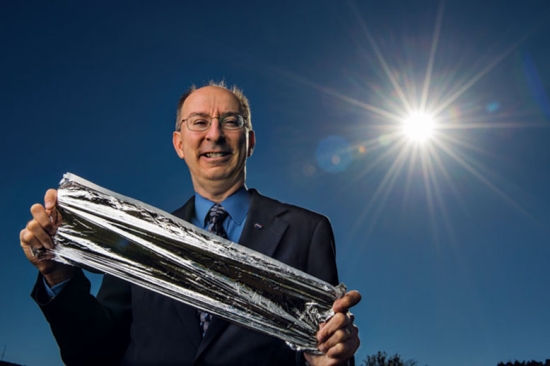
Image: Les Johnson, shown here with a sample of solar sail material that may one day be used to send a spacecraft deep into the outer system using only the pressure of sunlight for propulsion.
Are there other kinds of nannies that can raise children? The child whose voice introduces the tale seems to have few problems with hers:
Yesterday was Birthday One and we had a big party. Nanny said the day the first group of us were born was the happiest in memory. Thirteen Earth-years ago, the first fifty of us were removed from the artificial wombs and put in Nanny’s care. Fifty. I cannot even begin to imagine what it was like shepherding fifty babies, and then toddlers, around the house. But then I remembered that eight of the first group died, leaving just forty-two. Nanny doesn’t like to talk about that and has never told us exactly what happened to them.
I won’t either — no spoilers here — but how humans fit into the loop of automated systems is very much on Johnson’s mind in this cunning tale. An expert in deep space propulsion with extensive experience in solar sails (he is principal investigator for a mission we’ve discussed here, Near-Earth Asteroid Scout, as well as the much more ambitious Solar Cruiser), Johnson is an author and editor who sees abundant scope for humans as we populate first the Solar System and then nearby stars, beings who, “no matter their form, will be much like us.”

Homo Stellaris: Space and Human Transformation
In the sixteen years I’ve been writing Centauri Dreams, I’ve often used written science fiction to illustrate points about our ongoing science discussions. This also gives me a chance to poke around in my collection of old SF magazines, always a pleasure, as I’ve been collecting them since i was a boy and they go back to the glory days of newsstand fiction, which extended well beyond SF to mysteries, westerns and the various other genres defined by the pulp magazines of the early 20th Century.

What a kick, then, to read a short story by Robert E. Hampson and find a starship named Centauri Dreams! Not only that, but Robert, a professor of physiology and pharmacology at Wake Forest School of Medicine, gives me a nod by naming the orbital hub through which travelers pass in the story ‘Gilster Station.’ Thank you, Robert!
The story is “Those Left Behind,” which appears in the collection Stellaris: People of the Stars, a volume Hampson edited with Les Johnson. First published in 2019, the book now emerges in a new paperback edition from Baen Books. Hampson’s story is provocative, dealing with issues of human/machine augmentation that long-haul spaceflight may require. When humans reach the nearest stars, will they be human as we know the term, or an emerging branch of the species in charge of its own evolution?
Image: Wake Forest’s Robert Hampson, author and physiologist, who continues to explore the human response to space exploration. Credit: Wake Forest University.
The great question hanging over all this is whether there are human traits that would endure despite not just mental but physical transformation. We can imagine, as Hampson does, the reaction among those who will find augmented humanity a step too far. Here the question disrupts a family even as they look toward a colony at Proxima Centauri and ponder what it will take to get people there, all the while dealing with an emerging movement of those committed to ending human modification:
“You thought because I didn’t meet your expectation of a human — that I was bioengineered for low gravity — that I would be weak?” Sandy stood over the intruder, body language signaling anger and rage. “You argue about biological purity, about ‘unaltered’ humans, yet you live with modern medicine, vaccines, gene therapies and corrective surgeries.”…
“…simple spectrography,” Mace said, dismissively. “Diaminotoluene in the hair means hair color. Probably to cover the gray and change his appearance. Fine scars around the nose and eyes from plastic surgery — either vanity or to fool facial recognition. There’s a scleral scar and artificial lens in his right eye.”
Sandy practically snarled. “So, correcting your vision and changing your appearance with surgery is okay for you — just not for the people who are trying to give mankind a future?”
Some of us started reading science fiction in the first place because a good writer can pick up an idea like this and rotate it in and out of our present and into the future, forcing the big questions that technology enables, or perhaps demands. I know Robert Hampson from our encounters at conferences, the last one being the Tennessee Valley Interstellar Workshop’s 2017 symposium in Huntsville, where he moderated a panel on human life off-planet and a working track on the role of security and intel in space. “Those Left Behind” reminds me why he has become a go-to guy for science fiction writers pondering just what homo stellaris will be.
Where Intelligent Life Goes
Stellaris: People of the Stars collects fiction as well as non-fiction essays on just the matters addressed above, the changes that expansion in the universe may force upon our species. Although not limited to authors at the event, the book draws on many discussions at the Tennessee Valley Interstellar Workshop’s 2016 symposium, which was held in Chattanooga, TN, and included a working track on the transition of the human body and mind to the interstellar environment. I should note that the organization now does business as the Interstellar Research Group at irg.space.

Over the years I’ve gotten to know many of the authors within the volume, but I’ve only had one chance to meet Sir Martin Rees, Britain’s Astronomer Royal, though to be honest that was just a brief introduction at one of the Breakthrough Starshot meetings. But revisiting Robert Hampson’s story gives me a chance to talk about Rees’ essay “The Future of Intelligent Life in the Cosmos,” from the same volume. Rees is intrigued, to say the least, by exobiology, and is the author of On the Future: Prospects for Humanity (Princeton 2018), among numerous other books and essays.
Image: Martin Rees, astrophysicist, cosmologist and Britain’s Astronomer Royal.
One of the changes that have become apparent about public perception of these matters in the past two decades has been the commonplace discovery of exoplanets, which have gone from being a curiosity to an almost daily news item, their wide range a matter for comment and speculation. Rees speaks of this as being ‘morale-boosting,’ which it is to those anxious to identify other life in the universe, but a biosignature, perhaps detectable in a few decades, is a different thing entirely from a technosignature, and it’s an open question how humanity would react to the latter.
The challenge of estimating human reaction is that, as the Hampson story explores, humanity itself may be on the cusp of change, which may include not only genetic modification but augmentation through artificial intelligence. Thus biotech looms large as we make decisions about the relationship we choose to have with technology. In space, we continue to mine data from Cassini, New Horizons and Rosetta, even as we look forward to exploring the Jovian satellites through missions like the European Space Agency’s JUICE, with its intention of orbiting Ganymede, and NASA’s Europa Clipper. A key fact: We’re getting better and better at robotic exploration. The question this forces is inevitable. Says Rees:
The next step will be the deployment of robotic fabricators in space that can build large structures. For example, giant successors to the James Webb Space Telescope (JWST) will have immense gossamer-think mirrors assembled under zero gravity. These structures will further enhance our imaging of exoplanets as well as the cosmos. Will there be a role for humans?
Good question. Rees readily admits the powers of human observation (“It cannot be denied that NASA’s Curiosity, trundling across a giant Martian crater, may have missed startling discoveries that no human geologist could overlook”). Even so, he makes the case that the startling advance of machine learning coupled with sensor technology, not to mention the cost differential between manned and unmanned missions, means that the case for manned spaceflight is less clear-cut than it was a few decades ago.
While we explore the question, the near-term future for humans in space hinges on what Rees calls “inspirationally led private companies” who will engage in manned launches in terms of competition. This is a high-risk environment that reminds me of the early days of aviation, when records fell almost daily as pilots pushed their equipment higher and faster than ever before. Such adventurers may well wind up reaching other nearby worlds, where the changeable nature of humanity comes into play:
The pioneering explorers will be unsuited to their new habitat, sustaining a more compelling incentive to adjust themselves compared to those of us still on Earth. They will harness the powerful genetic and cybernetic technologies that will be developed in future decades. These techniques will be heavily regulated on Earth as well as on prudential and ethical grounds; however, settlers on Mars will exceed the clutches of regulators. Therefore, we should wish them luck in modifying their progeny to adapt to alien environments, as this might be the first step toward divergence into a new species. Ultimately, it will be these brave space voyagers who lead the post-human era.
I think about this often in terms of longer-range missions into the interstellar medium. Assume for a moment not one but many habitats in space, O’Neill-type arcologies housing larger and larger numbers of people in coming centuries who find the prospect of an engineered vs. a natural world enticing. If this happens, surely one day the idea of simply untethering from the Sun’s gravitational influence will strike some as irresistible. Imagine such a worldship nudging out into the Oort Cloud, to exploit the abundant cometary resources available there, and perhaps eyeing passage to another star. How many centuries will it take for such beings to diverge from our species?
So that maybe we don’t reach another stellar system and meet the aliens. Maybe the explorers who, after centuries or millennia, arrive at Wolf 1061c or Proxima Centauri b, are the aliens, at least in terms of their differentiation from ourselves.
Staying Human Closer to Home
We may have to make changes to our physiology if we plan to create a long-term human presence in space, by which I mean actual people living full-time off-world, either on planets or in the kind of structures I’ve mentioned above. And we can’t rule out the possibility that the advantages of electronic intelligence will simply be too great, causing our descendants to largely continue interstellar exploration with robotics of a kind so advanced over what we have today that they do indeed seem magical. I imagine Arthur C. Clarke would be right at home with a prospect like that.
It’s striking, then, to see how swiftly we dismiss some of the major issues regarding humanity in space when we look at what does seem feasible soon, a trip to Mars. In particular, I can remember a presentation that Robert Hampson makes about gravity and its lack. Mark Shelhamer, in the same Stellaris volume, goes into the question, a good thing because we’ve only begun to examine it seriously. It’s simply not enough to put astronauts in an environment like the ISS and take notes. We also have to ask what happens to humans longer-term, colonists on Mars, say, who plan to live out their lives in 0.38 Earth gravity. Does the body ultimately adapt or not?
Some of these issues have already come up in manned spaceflight close to home. We’ve learned about problems in visual acuity from extended ISS stay, evidently due to fluid pressure changes that move toward the back of the eye over time, distorting the shape of the eye and distorting its optical properties. Shelhamer (Johns Hopkins) is well suited to examine the questions this raises. He has worked with NASA on sensorimotor adaptation to spaceflight; he also is an advisor to the commercial spaceflight industry, and has served as chief scientist for the NASA Human Research program at JSC.

Image: Mark Shelhamer examining zero-g aboard NASA’s ‘vomit comet,’ a modified Boeing jet that simulates the weightlessness of the ISS. Creedit: Johns Hopkins Medicine.
Gravity is, of course, only one of the factors he discusses in his essay, but I focus on it because research on the matter seems so crucial and yet relatively unexplored. We do know to provide exercise venues for orbiting astronauts to maintain bone integrity and cardiovascular function as well as keeping muscles tuned for eventual return to Earth. But we still have much to learn, including the vital question of bone mineral density as it applies to bone strength and the interrelation between the two in internal structure.
ISS astronauts get about two hours of exercise per day per person (which also offers a mental break from the various demands of the job). So you could say that the ISS is a laboratory in gravitational studies impacting physiology, but we need a better one. Delivering a debilitated crew to the Martian surface serves no one well, so we need to find out whether the spacecraft that carry our astronauts there will need artificial gravity. We can induce the effect by rotating the craft in a variety of configurations, but it clearly has a huge impact upon design. How much artificial gravity do we need?
What we need in the short term is an orbiting laboratory that can explore these questions, a structure designed specifically to treat human issues in space and in particular questions of human performance under varying levels of g. In an ideal universe we would manage artificial gravity by using constant acceleration to target, with a turnaround at the halfway point. Lacking that capability, our best bet is rotation inducing a centripetal force proportional to the distance from the rotation axis. We’ll want to vary artificial gravity through spinning.
That, of course, raises a slew of other questions. Just how much artificial gravity do we need, and at what level? It’s possible that parts of a long-haul spacecraft might rotate while others do not, so that the crew might sleep, for example, in zero g and work much of the time in an artificial gravity environment. We know that many of the problems of bone and muscle mass loss could be avoided through artificial gravity, but we don’t have much experience with the vestibular system involving the balance organs in the inner ear, which is used to orient a person within inertial reference frames.
We don’t, in other words, know enough about rotating environments, and we need to explore how to mitigate their effects. We also need to consider, as Shelhamer goes on to point out, that weightlessness may have beneficial effects of its own. Here the psychological effects of space upon the crew may come into play. The famous ‘overview effect,’ explored by Frank White in his book of the same name in 1998, may partially be the result of the zero gee environment. It would be useful to explore possibilities that involve rotating only part of the spacecraft, providing living quarters that include artificial gravity for at least part of the astronaut working day.
The prospect of physiological transformation is something we also need to learn a great deal more about. Let me quote Shelhamer on this intriguing point:
Faced with a dramatically different environment — altered gravity level, unfamiliar atmospheric pressure and composition, different magnetic field, to name a few — evolutionary processes in the human organism might be accelerated. Under such circumstances, epigenetic alterations might take on a larger role in the heritability of acquired traits. Whatever the mechanism, settlers will likely be faced with the problems inherent in rapid change — only this will involve changes to the humans themselves. The possibility that some of these changes will be undesired — and could interact with other changes to the overall detriment of the person — should not be ignored.
Do we acknowledge such adaptive alterations if they begin, or do we try to slow them down? In other words, do we willfully let our species branch into new physiological directions, or do we try to mitigate the possibility? Here we also need to look at the role of genetic modification, about which we need to be cautious. As Shelhamer says, “in a space-settler setting where there is precious little backup capability (you can’t go home again) even subtle second-order effects can take on outsized significance.”

Ganymede: Largest Impact Crater in the Solar System?
Have a look at what two of our older spacecraft saw on Jupiter’s giant moon Ganymede, a world that will snap into much greater focus once the JUICE mission arrives in 2029. The JUpiter ICy moons Explorer is slated for launch in 2022, with the intention of studying Ganymede, Callisto and Europa. But it’s Ganymede that will get the lion’s share of the attention from this European Space Agency effort as JUICE slides into orbit around the moon in 2032, marking the first time a spacecraft has orbited a moon circling a planet other than our own.
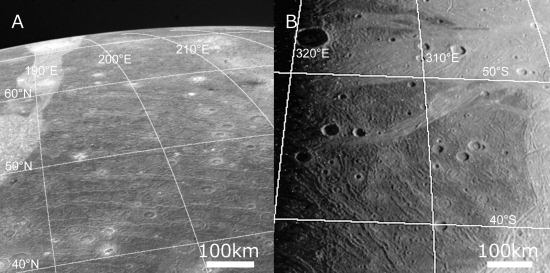
Image: Images of Ganymede’s surface taken by Voyager 2 (left) and Galileo (right). The Dark Terrain and Bright Terrain areas can be recognized, with concurrent furrows present in the Dark Terrains. Credit: NASA.
We looked at more recent Juno views of Ganymede just last month (see Glimpses of Ganymede), along with interesting results from its most recent flyby on disruptions in the crystalline structure of the moon’s north polar ice due to incoming plasma. Now we return to Jupiter space because of a new paper from Naoyuki Hirata (Kobe University) and colleagues that examines the orientation and distribution of tectonic troughs on Ganymede’s surface. Their concentric arrangement implies what may be the largest impact structure identified in the Solar System. The data used in the work come from both Voyagers and the Galileo spacecraft.

Image: Azimuthal equidistant map centered at 20° south 180° west showing Ganymede’s Dark Terrain and furrows (indicated by yellow lines). (Bottom) Azimuthal equidistant map of Ganymede’s surface centered at 20° north and 0° west. This shows the opposite hemisphere of Ganymede from the top image. The white areas indicate Bright Terrain. Credit: NASA.
Hirata’s team used computer simulations at the National Astronomical Observatory of Japan (NAOJ), speculating that what we are looking at is the result of an asteroid impact, a mighty blow struck by an object significantly greater than 50 kilometers in radius, and perhaps as much as 150 kilometers in radius, moving at 20 kilometers per second.
Almost all the furrows found in the spacecraft imagery are concentric rings aligned around a single point centered at 20°S 180°W, with the radial extent of the structures measuring 7800 kilometers. Bear in mind that the mean circumference of Ganymede is only 16,530 kilometers. If we really are seeing a crater here, it dwarfs Callisto’s 1900 kilometer crater, previously thought the largest in our system.
A 150 kilometer impactor would produce a melt pool with a radius of 1000 kilometers, a possible explanation for the central region of Ganymede’s Marius Regio, which is free of furrows. Usefully, the Hirata simulations lead to a prediction that we will soon be able to test. From the paper:
Our numerical impact simulation for the case of Rimp = 150 km (Rimp
=50 km) demonstrates the generation of a large melt region with a radius of ~1000 km (~500 km). This large melt region would allow the dense material to gravitationally segregate, which generate positive gravity anomaly such as mass concentrations seen on the lunar impact basins. Therefore, we predict that, if our view is correct, positive gravity anomaly with a radius of ~1000 km when Rimp = 150 km (or a radius of ~500 km when Rimp = 50 km) should exist around 20°S 180°W. This can be tested by future geodetic observations of Ganymede such as the JUICE (Jupiter Icy moon Explorer) or Europa Clipper mission.
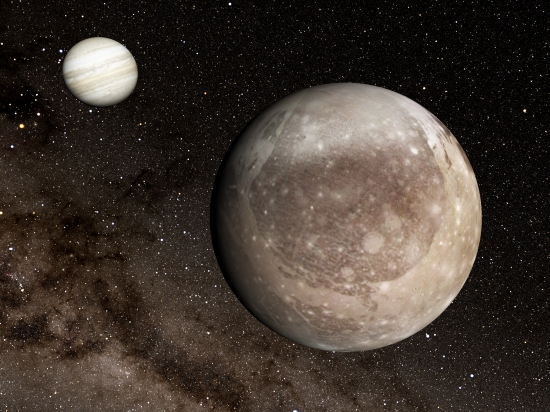
Image: Jupiter (background, left) and its moon Ganymede (foreground, right) visualized using the Four-Dimensional Digital Universe viewer “Mitaka.” The furrows found on the older, Dark Terrain, areas of Ganymede’s surface could actually be parts of a single, giant, multiring impact crater. Credit: Tsunehiko Kato, 4D2U Project, NAOJ.
The paper is Hirata et al.,”A global system of furrows on Ganymede indicative of their creation in a single impact event,” Icarus Vol. 352 (July 15, 2020), 113941 (abstract).

95 Nearby Cool Brown Dwarfs Identified
The boundary between planet and star is hard enough to pin down without thinking of some recently discovered brown dwarfs that are cool enough to approach Earth temperatures. Yet worlds/stars like these are among the haul assembled by volunteers working data for Backyard Worlds: Planet 9, a citizen science project whose latest findings include 95 cool brown dwarfs in the Sun’s neighborhood, as reported in the Astrophysical Journal.
Despite a determined search, we’ve yet to find such an object closer than the nearest stars at Alpha Centauri. But 23 light years out — the distance of the closest of these brown dwarfs — is definitely close in galactic terms, and most of the brown dwarfs tracked in the new work are between 30 and 60 light years from Earth. That makes sense, for objects like these are faint enough that identifying them at greater range is all but impossible.
The data used in the brown dwarf collection come from a range of observatories including W. M. Keck, Mont Mégantic, Las Campanas, Kitt Peak and Cerro Tololo. Space-based data from WISE (Wide-field Infrared Survey Explorer) were also valuable, as were follow-up observations from the Spitzer Space Telescope providing photometric confirmation. Low temperature brown dwarfs like these build our catalog while also clarifying gaps in the low-temperature population.
Jackie Faherty (American Museum of Natural History) is a co-author of the paper, whose lead author is Aaron Meisner (NSF NOIRLab). Faherty places the work in context, while giving a nod to the Backyard Worlds participants:
“This paper is evidence that the solar neighborhood is still uncharted territory and citizen scientists are excellent astronomical cartographers. Mapping the coldest brown dwarfs down to the lowest masses gives us key insights into the low-mass star formation process while providing a target list for detailed studies of the atmospheres of Jupiter analogs.”
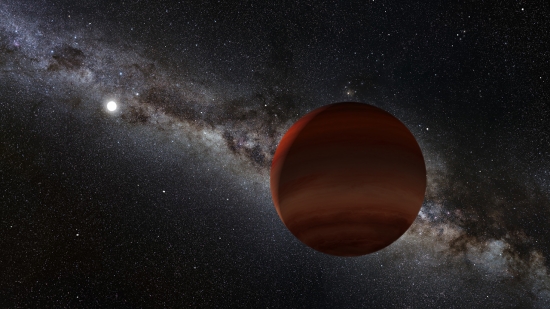
Image: Artist’s impression of one of this study’s superlative discoveries, the oldest known wide-separation white dwarf plus cold brown dwarf pair. The small white orb represents the white dwarf (the remnant of a long-dead Sun-like star), while the brown/orange foreground object is the newly discovered brown dwarf companion. This faint brown dwarf was previously overlooked until it was spotted by citizen scientists, because it lies right within the plane of the Milky Way. Credit: NOIRLab/NSF/AURA/P. Marenfeld. Acknowledgement: William Pendrill.
We can also thank NOIRlab’s Community Science and Data Center (CSDC), which made the large survey sets available through its Astro Data Lab science platform. The web portal makes matching data sets from a variety of observatories available to citizen scientists. Meisner adds:
“The technical burden of downloading billion-object astronomical catalogs is typically insurmountable for individual investigators—including most professional astronomers. Thankfully, the Astro Data Lab’s open and accessible web portal allowed Backyard Worlds citizen scientists to easily query massive catalogs for brown dwarf candidates.”
The authors make the point that some of the objects in this study will be potential targets for follow-up spectroscopy by the James Webb Space Telescope:
Among our most exciting discoveries are new candidate members of the 10 pc sample, two objects moving faster than 200″/yr, three T type subdwarf candidates, five Y dwarf candidates, and a new T8 plus white dwarf co-moving system. Our Y dwarf candidates begin bridging the gap between the bulk of the Y dwarf population and the coldest known brown dwarf, making them potential targets for JWST spectroscopy. Backyard Worlds is actively pursuing additional ground-based follow-up of the discoveries presented in this study, especially spectroscopy where feasible. While this work’s new brown dwarf candidates already demonstrate the power of citizen science for mapping the solar neighborhood, these objects make up only a small fraction of Backyard Worlds moving object discoveries to date. As NEOWISE continues scanning the sky, Backyard Worlds will endeavor to search all of its newly delivered data for yet more cold and close neighbors to the Sun.
Backyard Worlds volunteers have discovered more than 1,500 stars and brown dwarfs near the Sun. The current batch represents some of the coldest brown dwarfs in that collection. More than 100,000 citizen scientists are involved in the project, a network that examines telescope images to identify the movements of nearby dwarfs and planets. Putting human eyes on large data sets is integral to the search for rare objects, an approach astronomers will exploit with data gathered by the Vera C. Rubin Observatory (VRO). Now under construction in the Chilean Andes, the instrument will survey the southern hemisphere sky every three nights over a ten year period.
The paper is Meisner et al., “Spitzer Follow-up of Extremely Cold Brown Dwarfs Discovered by the Backyard Worlds: Planet 9 Citizen Science Project,” accepted at the Astrophysical Journal (preprint).

‘Oumuamua: A Hydrogen Iceberg?
Studies of interstellar interloper ‘Oumuamua move at lightning pace, to judge from a recent exchange on hydrogen ice. A study by Greg Laughlin and Darryl Seligman (both at Yale) just published in June, has now met a response from Thiem Hoang (Korea University of Science and Technology, Daejeon) and Harvard’s Avi Loeb. The issue is significant because if, as Laughlin and Seligman argued, ‘Oumuamua were made of hydrogen ice, then the outgassing that drove its slight acceleration would not have been detectable. At least one mystery solved.
Or was it? One reason the 0.2km radius object didn’t fit the description of a comet was that there was no explanation for its tiny change in velocity. Hoang and Loeb have examined the hydrogen ice concept and found it wanting. Says Hoang:
“The proposal by Seligman and Laughlin appeared promising because it might explain the extreme elongated shape of ‘Oumuamua as well as the non-gravitational acceleration. However, their theory is based on an assumption that H2 ice could form in dense molecular clouds. If this is true, H2 ice objects could be abundant in the universe, and thus would have far-reaching implications. H2 ice was also proposed to explain dark matter, a mystery of modern astrophysics.”
Which sounds interesting in itself because anything bearing on dark matter is worth a look, given our frustration at understanding the matter behind the hypothesis. Laughlin and Seligman had suggested a giant molecular cloud [GMC] as the origin for ‘Oumuamua, but Hoang and Loeb argue that the earlier paper, while considering the destruction of H2 ice in the interstellar medium through evaporation, did not take into account the improbability of such ices forming within a GMC, or the effects of that environment upon their later growth. From the paper:
Assuming that H2 objects could be formed in GMCs by some mechanisms (Füglistaler & Pfenniger 2016; Füglistaler & Pfenniger 2018; Seligman & Laughlin 2020), we quantify their destruction and determine the minimum size of an H2 object that can reach the solar system. We assume that the H2 objects are ejected from GMCs into the ISM by some dynamical mechanism such as tidal disruption of bigger objects or collisions (see Raymond et al. 2018; Rice & Laughlin 2019).
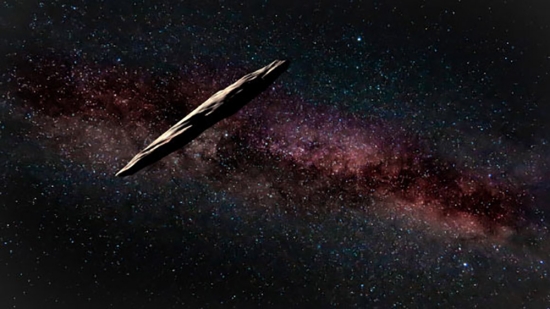
Image: An artist’s rendering of ‘Oumuamua, a visitor from outside the Solar System. Credit: The international Gemini Observatory/NOIRLab/NSF/AURA artwork by J. Pollard.
Hoang and Loeb’s calculations show that H2 icebergs are unlikely to grow to large size because of collisional heating not just from dust but from gas within the birth cloud, meaning that ‘Oumuamua likely wasn’t a hydrogen iceberg (and, along the way, taking out the ancillary proposition that dark matter may be accounted for by H2 snowballs). Micron sized grains in regions where the density of gas is high will cause the hydrogen on the grains to sublimate.
Assuming that H2 objects could somehow form in the densest regions of GMCs, we found that sublimation by collisional heating inside the GMC would destroy the objects before their escape into the ISM [interstellar medium]. We also studied various destruction mechanisms of H2 ice in the ISM. In particular, we found that H2 objects are heated by the average interstellar radiation, so that they cannot survive beyond a sublimation time of tsub ~ 10 Myr for R = 300 m (see Figure 1). Only H2 objects larger than 5 km could survive.
While giant molecular clouds like (GMC) W51, one of the closest to Earth at roughly 17,000 light years, could be a point of origin for the object, the authors argue that even this close GMC is simply too far away. Moreover, it might be hard for a hydrogen iceberg even to exit the giant molecular cloud in the first place. Collisional heating within a GMC would destroy objects like this through thermal sublimation long before they reached a distant stellar system. The paper finds that objects below 200 meters in radius would be destroyed within the parent GMC.
We also have to find a way to get ‘Oumuamua all the way from its birthplace to our Solar System. What Hoang and Loeb point out is that an iceberg made of hydrogen would be unlikely to survive an interstellar journey that would probably take hundreds of millions of years. An object like this is going to begin to evaporate. Their paper goes to work out the survivability of H2 ice from interstellar radiation given thermal sublimation and photodesorption along the way.
Many other factors come into play that cause problems for a hydrogen iceberg. It has to stand up to cosmic rays as well as impacts with matter in the interstellar medium. And we have to throw in what can happen when an object like ‘Oumuamua enters the Solar System, where solar radiation becomes an issue. The calculations presented here show the significance of thermal sublimation due to starlight, while going beyond this to reveal the effects of cosmic rays and impacts with interstellar matter, which turn out to be less significant.
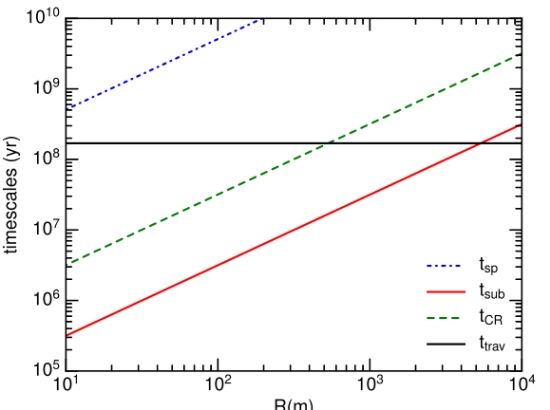
Image: This is Figure 1 from the paper. Caption: Comparison of various destruction timescales (slanted colored lines) as a function of the object radius (in meters) to the travel time from a GMC at a distance of 5.2 kpc, assuming a characteristic speed of 30 km s?1 (horizontal black line). Credit: Hoang & Loeb.
The authors calculate a minimum radius of H2 objects in the range of 5 kilometers for survival in a journey that would have to take in formation in giant molecular clouds and movement through the interstellar medium. 10 million years would wreak havoc on an object the size of ‘Oumuamua.
We’re in a period of energetic debate, a time when the unresolved questions about ‘Oumuamua remain in play. It seems clear that we need a larger population of interstellar objects to place the current work in context, and Loeb has pointed out that we won’t have long to wait:
“If ‘Oumuamua is a member of a population of similar objects on random trajectories, then the Vera C. Rubin Observatory (VRO), which is scheduled to have its first light next year, should detect roughly one ‘Oumuamua-like object per month. We will all wait with anticipation to see what it will find.”
The paper is Hoang & Loeb, “Destruction of Molecular Hydrogen Ice and Implications for 1I/2017 U1 (‘Oumuamua),” Astrophysical Journal Letters Vol. 899, No. 2 (17 August 2020). (Abstract). The Seligman & Laughlin study that argued for “‘Oumuamua as a hydrogen iceberg is “Evidence that 1I/2017 U1 (‘Oumuamua) was Composed of Molecular Hydrogen Ice,” Astrophysical Journal Letters Vol. 896, No. 1 (9 June 2020). Abstract.

A Fast Inflatable Sail Using Desorption
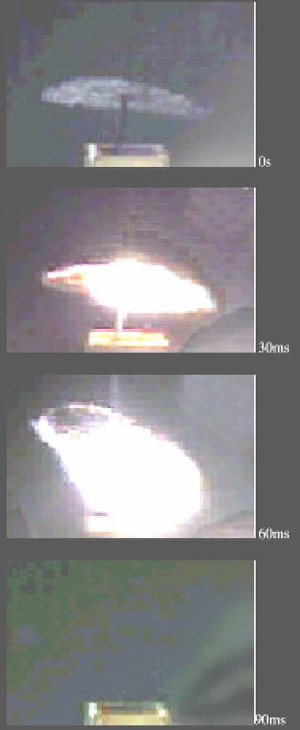
The first laboratory work on pushing a space sail with microwaves was performed by Jim and Greg Benford at the Jet Propulsion Laboratory back in 1999, with the results presented the following year at a European conference. Leik Myrabo (then at Rensselaer Polytechnic Institute) was, at about the same time, performing experiments with lasers at Wright-Patterson Air Force Base in Ohio. When you think about the problems of laboratory work on these matters, consider the fact of gravity, meaning that you are working in a 1 g gravity well with diaphanous materials whose acceleration depends on how hot you can allow them to become.
Advances in materials and in particular in lightweight carbon structures allowed the Benfords’ experiments to succeed, with the help of a 10-kilowatt microwave beam that produced significant acceleration on the test object. But I’m reminded by looking at a new paper on sail technologies using no beam at all that the Benfords also demonstrated something else. Molecules of CO2, hydrocarbons and hydrogen that had been incorporated in the lattice of their material at manufacture emerged under the high temperatures involved. Thus another form of acceleration came into play through the phenomenon called desorption.
Image: Carbon disk sail lifting off of truncated rectangular waveguide under 10 kW microwave power (four frames, 30 ms interval, first at top). Credit: James and Gregory Benford.
Just how useful an effect may desorption turn out to be? It seems to offer an acceleration dividend. Roman Kezerashvili (City University of New York), working with colleagues at Samara National Research University in Russia and the State University of New York at Buffalo, has now analyzed the effect of desorption on an inflated, torus-shaped sail. I had the pleasure of talking with Dr. Kezerashvili in Italy at the Aosta conference in 2009, where he discussed relativistic effects that have to be taken into account in the navigation of a space sail close to the Sun. The current work follows up an earlier paper on desorption he presented in 2016.
We have the prospect of incorporating compounds into a sail that become a kind of propulsive shell that is triggered either by microwave beam or, in the case of a close Solar pass, by the Sun itself. Think of desorption as involving a kind of propulsive ‘paint.’ In terms of beaming, it is necessary to understand that desorption can take place under either microwave or laser beam, but microwaves do not damage sail materials and so heat them far less destructively. The Benfords’ work, as Kezerashvili points out, shows that microwave beaming produces more efficient absorption in the sail’s coating materials, and high specific impulse can result from desorption.
In fact, in the Benford experiments on ultra-light carbon sails, photon pressure can account for no more than 30 percent of the observed acceleration. The rest comes from desorption.
Various materials can undergo desorption at different temperatures — the sail analyzed by Kezerashvili in 2016 uses carbon, whose properties of acceleration are there analyzed. If low mass atoms or molecules can be blown out of the sail lattice at known temperatures, the mission concept Kezerashvili suggested in that 2016 paper can emerge, one in which the sail reaches desorption temperature at a particular point in a close pass around the Sun. In this scenario, no microwave or laser beam is needed:
It is of particular interest to consider an inflatable torus-shaped solar sail as both propellant-less and propellant-based system. It is a propellant-based and a propellant-less system which create thrust by the sun-driven ejection of a flux of particles of non-zero rest mass due to the desorption of coating and solar radiation pressure, while it performs as a propellant-less conventional solar sail after the thermal desorption ends.
As far as I know, this new paper is the first analysis of desorption on an inflatable sail, but inflatable structures have a long history due to their flexibility and low volume at launch. Among the earliest inflatables to be used in space were the Echo balloons launched in the 1960s, but inflatable structures have been developed extensively in the decades since. I’ve written in the past on a hydrogen-inflated sail using a molybdenum reflector that became the basis for an early orbiting radio telescope design, a concept Greg Matloff extended and investigated along with Kezerashvili and Italian physicist Giancarlo Genta for interstellar flight purposes.
This is also the first paper that considers thermal desorption in the context of solar heating alone, which leads to an interesting class of ‘sundiver’ missions with close solar passes. Thus a conventional solar sail coated with desorptive paint is heated by the space environment.
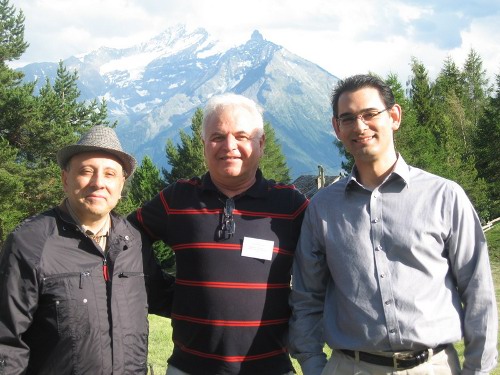
Image: From the Aosta conference of 2009, a fine memory: A snapshot taken in the Italian Alps. Left to right: Giovanni Vulpetti, Roman Kezerashvili, and Justin Vazquez-Poritz.
On deployment matters: Most solar and beamed sails discussed in the literature assume systems of electromagnetic actuation devices, often involving guide rollers and booms. All of this, of course, adds to the mass of the resulting structure as well as its complexity. Deployment through a series of inflatable booms, as assumed in the inflatable sail concept, simplifies an otherwise intricate procedure. The paper also mentions the advances in flexible polymers and high-strength fibers that allow more mass packed into the launch vehicle at lower cost.
So inflatable sails make sense. The new Kezerashvili paper looks at the dynamics of an inflatable sail, conceived as “a thin reflective membrane attached to an inflatable torus-shaped rim.” The round, flat membrane is coated with heat sensitive materials that make the transition from solid state to gas. Pressure introduced into the rim allows sail deployment from the initial stowed configuration, with deployment occurring at the chosen heliocentric distance.
At this point the sail membrane is extended into its final flat shape, with thermal desorption occurring at a specific temperature. For the purposes of these calculations, the authors cite an acceleration time for the torus-shaped solar sail due to thermal desorption of about 1500 seconds, with the mass of the coating material pegged at 1.5 kg and a desorption rate of 1 g/s.

Image: This is Figure 1 from the paper. Credit: Kezerashvili et al.
And here is a figure from one of Dr. Kezerashvili’s presentations on the inflated sail.

Thus we wind up with two types of acceleration at perihelion, the first being the expected solar radiation pressure, the second being that caused by thermal desorption from the sail itself. The authors assume a beryllium-coated solar sail and analyze the membrane mass of the sail as well as the toroidal rim and coating material, along with the desorption rate, under varying molecular hydrogen gas fills and a temperature range varying with the perihelion approach considered. The different gas fills change the tensile stress on the sail membrane. The paper analyzes the structural strength required in the inflatable torus to support the circular membrane of the sail and considers the deflection of the membrane due to acceleration.
A ‘sundiver’ maneuver is a mission scenario we’ve discussed often in these pages — only this one occurs with an inflatable sail, and it is a mission in which the sail is deployed just as the appropriate temperature is reached. The additional kick provided by desorption produces a substantial boost in performance over a sail driven by solar radiation alone:
The present study reveals that the inflation deployed torus-shaped solar sail accelerated via thermal desorption of coating results in high post-perihelion heliocentric solar sail velocities. With the speed 20-40 AU/year, post-perihelion travel times to the vicinity of Kuiper Belt Objects (KBO) will be less than 1-3 years, while the Sun’s gravity focus at 547 AU can be reached in 13-25 years.
What interested me in particular was the idea of extending the concept into small sails and opting for a ‘fleet’ concept:
The suggested configuration of the torus-shaped solar sail fits the cube-scale size configurations. Recent research reveals that much smaller sails could be incorporated with highly miniaturized chip-scale spacecraft. It is quite possible that a single dedicated interplanetary ”bus” could deploy many cube-scale sails at perihelion. Sequential deployment of a fleet of solar sails could be timed to allow exploration of many small KBOs from a single launch. The natural continuation of this work can be extended in the following directions: i. Detailed research on materials for thermal desorption at temperature suitable for solar sailing; ii. consideration of the Sun as an extended source of radiation; iii. study the influence of solar sail surface oscillations on the motion of a spacecraft performing an interplanetary flight.
Interesting issues arise with a sail like this. The coating on the surface of the sail must be uniform, and in fact one would expect that slight variations will occur that can lead to trajectory deviations during the desorption process. Remember that the time of desorption acceleration is small, around 1500 seconds, in the configuration discussed here. The authors assume there would be a need for periodic corrections in the sail’s tilting angle as these deviations occur. You can also see how neat a fit this work makes with Kezerashvili’s earlier studies on navigation issues deep in a gravity well. An error in relativistic calculations close to the Sun could lead to substantial variations in the final trajectory.
The paper is Kezerashvili et al., “A torus-shaped solar sail accelerated via thermal desorption of coating,” in press at Advances in Space Research (abstract). The original 2016 paper is Ancona and Kezerashvili, “Orbital dynamics of a solar sail accelerated by thermal desorption of coatings,” Proceedings of 67th International Astronautical Congress (IAC 2016), Guadalajara, Mexico, 26-30 September 2016. Paper IAC-16-C1.6.7.32480 (preprint). The comprehensive paper on extrasolar exploration by a solar sail accelerated via thermal desorption of a coating that grew out of this is published in Advances in Space Research 63, pp. 2021-2034 (2019).

